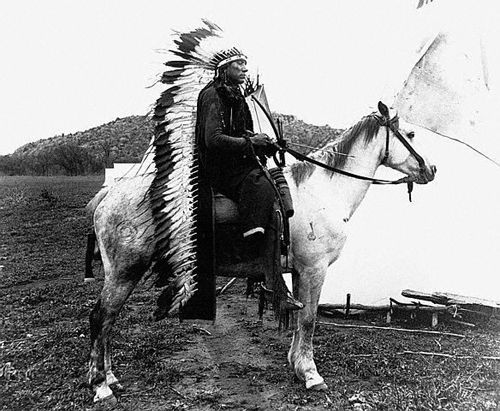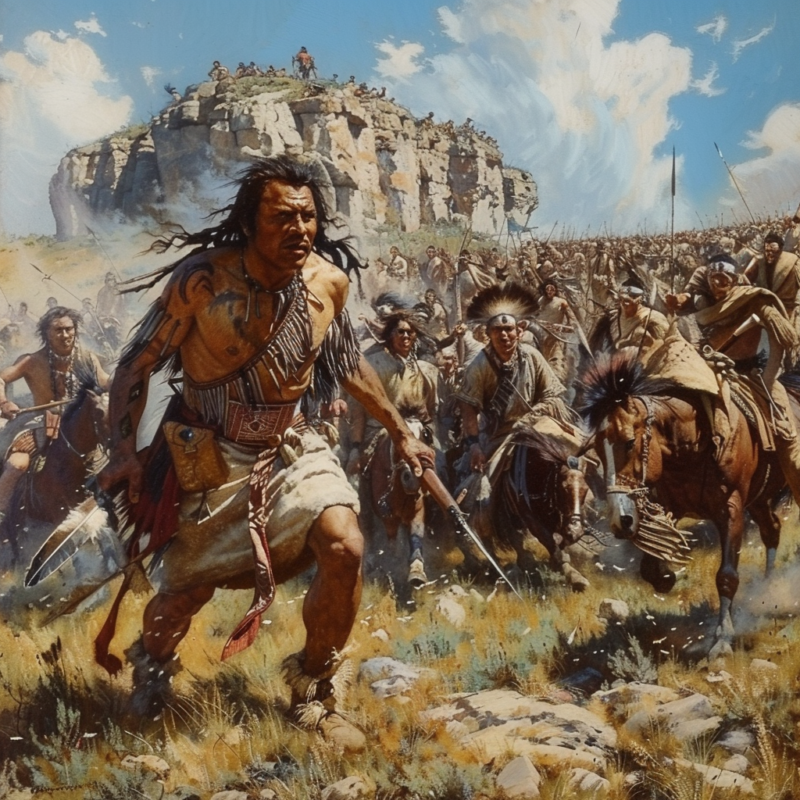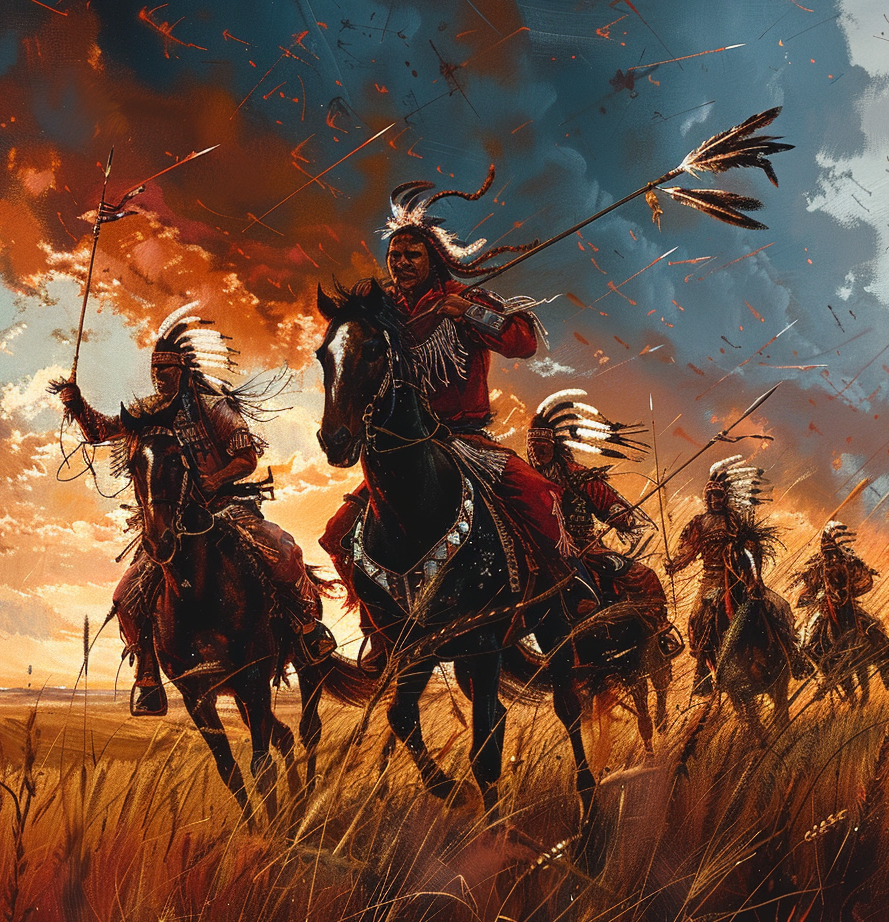The Comanche: The Most Powerful Native American Tribe in History
The Comanche Nation was once the most powerful in America and one of the most effective fighting forces in history. They fought off numerous foes and were only defeated in the late 19th century. Here’s the secret story of the Comanche, the most powerful Native American tribe in history.
Origins and Early Life
The popular image of the Native American in the 19th century invariably shows them as invincible warriors who lived their lives on horseback. And while the Comanche definitely live up to this image, it wasn’t always the case. The Comanche started as nomadic hunter-gatherers who moved to follow seasonal prey.
In many ways they lagged behind their peers. While the Aztec Empire was building incredible cities and the Iroquois were developing a sophisticated civilization, the Comanche built nothing and had no permanent settlements. They were also not particularly aggressive which might have had to do with the fact that they were not notably good warriors.
The Transformation
But all this changed in the late 17th century when the Comanche first encountered the horse. The Spanish introduced the animals to the Comanche, but the Native American tribe demonstrated an understanding of both how to master these incredible animals and how to translate that mastery into military force. Over the course of the next century, the hunter-gatherers of the Comanche nation transformed into a dominant aggressive empire of warriors and it was all due to their expertise in breaking, training, riding, and fighting with the horse.
Instead of sedentary tribes who were agricultural from the east, you had nomadic tribes who were mounted in the west, and it changed everything. For a tribe that had its beginnings as relatively peaceful hunter-gatherers, the Comanche’s transformation into a military juggernaut was total. Once they gained mastery over horses, their culture became almost solely focused on waging war.
Comanche Society and Training
Comanche society was very limited as a result. They didn’t have a religious structure or many social organizations. There was no manufacturing or even art.
Children learned how to ride, how to hunt, and how to fight from a very early age. Their entire lives were focused on those three aspects. In fact, the Comanches are sometimes compared to the Spartans in how they were almost totally focused on fighting.
Brutality and Warfare
The Comanches evolved into a force of violence that no one could withstand. They waged war on everyone who came in contact with them and they usually won. One reason for this success was their brutality.
A Comanche raid was a terrifying affair. All male enemies would be killed without exception even if they surrendered. Older children would be put to death as well.
Young children would be taken captive and the women would be assaulted and murdered. The Comanches waged total war long before the founding of the United States. In order to appreciate just how powerful and warlike the Comanches were at their height, you have to consider the fact that they came very close to wiping out several other Native tribes.
Aggression Against Fellow Native Americans
The Native Americans who resisted the expansion of the United States into the Midwest weren’t a single culture. They were a diverse group of separate nations that shared certain cultural characteristics and traditions. The Comanches were particularly aggressive against their fellow Native Americans and particularly effective at killing them.
They systematically pushed all the other tribes off the Central Plains, forcing them to find new lands to live within. In fact, the Comanches came very close to literally wiping out the entire Apache Nation. The warriors savagely defeated the weaker tribe in a series of conflicts that saw the desperate Apaches beg the Spanish for protection.
Several large tribes within the Apache Nation disappeared as a result of the conflicts. But it wasn’t just the Apaches. The Comanches inflicted severe damage on the Pawnees, the Osages, the Blackfeet, the Kiowas, and the Tancawas, driving them off their traditional lands and killing thousands of their people.
Rise to Power
By 1750, the Comanches had total control of the plains and other Native American nations respected their borders. The territory controlled by the Comanche was called the Comancheria by the Spanish and it grew with astonishing speed. After the transformation of their entire society into a mobile war machine, the Comanches began their rise to power as the lords of the plains.
Over the course of about 150 years, the Comanches steadily drove out rival tribes, conquering land and subjugating everyone they didn’t kill. When Americans began venturing west and finally brushed up against the Comancheria in the 1820s, it was massive. The Comanches controlled about 250,000 square miles including land within what would become Colorado, Kansas, Oklahoma, New Mexico, and Texas.
They also had vassals with about 20 other tribes acknowledging Comanche supremacy. According to historian Pekka Hammett-Lyon, this makes the Comancheria something more than just a Native American tribe or nation. It made it an empire.
The Empire of the Comanche
They conquered lands and absorbed other ethnicities and cultures, imposed their own political and military structures, and negotiated as a single unit. In fact, the Comanche empire was more powerful and more advanced than many of the European empires of the time. This is why the colonization efforts of the Spanish, French, and Americans were stalled whenever they pushed up against the Comancheria.
What’s remarkable about a lot of U.S. history is how the wars between the Comanches and the United States are often not described as wars at all. But make no mistake, the Comanches conducted a war against Texas that lasted nearly 40 years. Got him on the run.
Don’t be too sure. Looks like an old Indian trick to me. It began when Texas was still under Spanish control, continued while it was an independent state, and finally as part of the U.S. The Texas Rangers were founded in part to defend settlers against the Comanches and quickly adopted the total war approach that the Native American warriors practiced.
Final Defeat and Quanna Parker
But for decades Texas couldn’t stop the Comanches. In fact, they even expanded their territory into Texas on several occasions. It wasn’t until Texas joined the United States and President Ulysses S. Grant made defeating the Comanches a priority that they were finally pushed back, setting off a series of events that culminated in their final defeat in the 1870s.
A woman named Cynthia Ann Parker was kidnapped by Comanche raiders in 1836. She was assimilated into the tribe and eventually married and bore a son named Quanna Parker in 1852. By the time Quanna was an adult, the Comanche nation was in its final death throes and he was destined to be its last great leader.

As a youthful warrior, Quanna was the epitome of Comanche bravery and fierceness. Remarkably young for a chief, Quanna led a series of violent raids against American forces in 1871 when he was just 19 years old. In 1874, Quanna gathered 300 Comanche warriors and launched a final assault on the American forces encroaching on the Comancheria.
The chief intended to drive the Americans away once and for all, as the Comanche had always been able to do. They attacked a trading post called Adobe Walls where about 28 hunters had taken shelter. Instead of a shocking victory, it turned into a slog.
The siege lasted five days and ended with the Native Americans retreating. The Comanches continued to raid and slaughter, however, and American forces pursued, burning their supplies and killing their horses as they went. This broke the back of the Comanche nation and Quanna led his surviving warriors to surrender, agreeing to move to a reservation.
Quanna Parker: A Peacetime Leader
Quanna proved to be a popular and capable peacetime leader. He spent the rest of his life serving his people as the peaceful chief of the Comanche nation. By the 1870s, the Comanches were on the brink of defeat at the hands of American forces.
There were several reasons the U.S. was having some success after decades of failure against the Lords of the Plains. The brutal fighting of the Civil War left the U.S. with an experienced and well-equipped modern fighting force, U.S. forces were slaughtering the Native Americans’ primary food source, and President Ulysses S. Grant was determined to put an end to their power once and for all. But there was another factor at work — disease.
The Impact of Disease
As with many other Native American tribes, the more they traded and interacted with U.S. settlers, the more they fell victim to diseases like smallpox and cholera. Having never encountered them before, the Comanches had no defense against them. Two widespread epidemics in 1816 and 1849 had reduced the Comanche population by half.
In fact, one reason the Quahadi Band led by Quanna Parker was still a formidable fighting force in the 1870s is because they had always disdained any sort of peaceful contact with settlers. Having shunned the Americans pushing west, they had avoided these plagues. This left them as one of the few remaining Comanche Bands capable of resisting the U.S.’s march westward.




